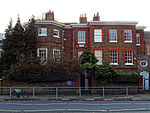Molesey Lock

Molesey Lock is a lock on the River Thames in England at East Molesey, Surrey on the right bank. The lock was built by the City of London Corporation in 1815 and was rebuilt by the Thames Conservancy in 1906. It is the second longest on the river at 81.78 m (268 ft 4 in); it is the second lowest of the non-tidal river and third-lowest including Richmond Lock on the Tideway. Upstream of the lock are moorings for small boats, specifically skiff, paddleboard, small speedboat and open kayak hire, a tour boat pier, a kiosk and van parking space for ice cream and soft drinks. A few metres upstream is a combined side weir and front weir followed by an attached ait, Ash Island. A low backwater against the opposite bank which forms the waterside to homes sometimes called the Hampton Riviera continues to a small upper weir. Molesey Lock is within sight of the walls of Hampton Court Palace in southwest London on the opposite bank through the arches of Hampton Court Bridge, designed by Edwin Lutyens (220 m away).
Excerpt from the Wikipedia article Molesey Lock (License: CC BY-SA 3.0, Authors, Images).Molesey Lock
Barge Walk, Elmbridge
Geographical coordinates (GPS) Address Nearby Places Show on map
Geographical coordinates (GPS)
| Latitude | Longitude |
|---|---|
| N 51.404722222222 ° | E -0.34583333333333 ° |
Address
Barge Walk
Barge Walk
KT8 9AJ Elmbridge
England, United Kingdom
Open on Google Maps











